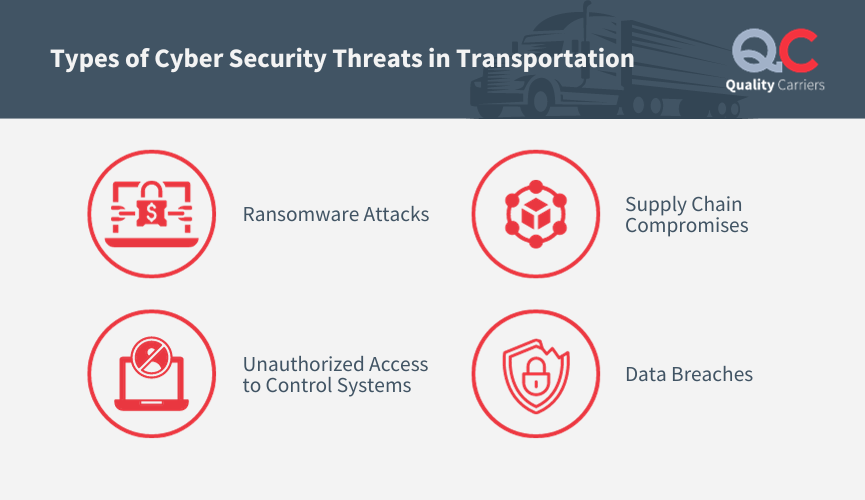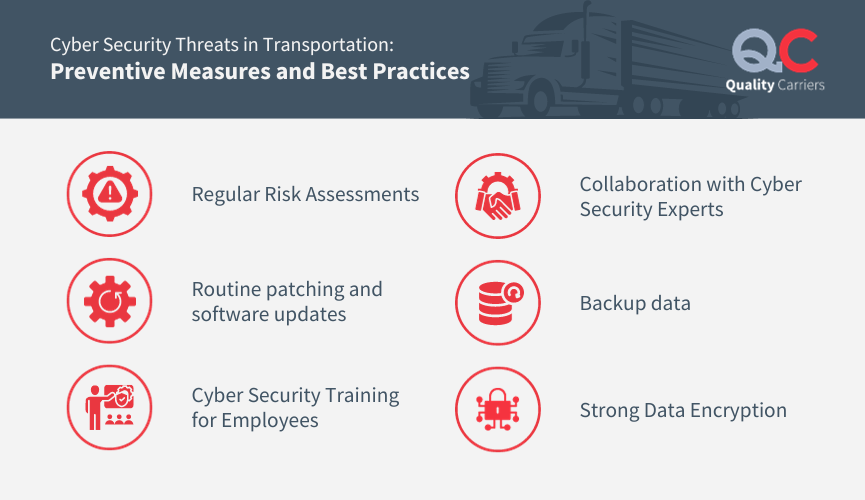In today’s interconnected world, transportation is vital in keeping societies functioning smoothly. However, with the increasing reliance on digital technology and connected systems, the industry is vulnerable to cyber security threats that can disrupt operations, compromise sensitive data, and even endanger public safety.
This blog explores the complex landscape of cyber security transportation, threats and risk factors, shedding light on the challenges and solutions crucial to safeguarding this critical industry.

Types of Cyber Security Threats in Transportation
The transportation sector has transformed digitally, with various systems and devices becoming interconnected. While this has increased efficiency and convenience, it has also opened the door to cyber threats that exploit vulnerabilities in these interconnected networks.
Ransomware Attacks
Ransomware attacks involve malicious actors infiltrating systems, encrypting data, and demanding ransom for its release. The transportation sector has not been spared from this menace. A study by Cybersecurity Ventures estimated that global ransomware damage costs would reach $20 billion by 2021. Such attacks can paralyze transportation operations, causing delays, service suspensions, and potential data breaches. The Colonial Pipeline incident in 2021, which disrupted fuel supply across the U.S. East Coast, highlighted the vulnerability of critical infrastructure to ransomware attacks.
Unauthorized Access to Control Systems
Cybercriminals seeking unauthorized access to control systems pose a grave risk to transportation safety. According to the FBI’s Internet Crime Complaint Center (IC3), cyber attacks targeting operational technology (OT) and control systems increased by 20% in 2020. A successful breach could lead to manipulated traffic signals, rail switches, or aviation control systems, potentially causing accidents and widespread disruptions. The Stuxnet malware attack in 2010 demonstrated the potential havoc of control system breaches by targeting Iran’s nuclear facilities.
Supply Chain Compromises
Supply chain involves cybercriminals exploiting vulnerabilities within the intricate web of suppliers, partners, and contractors that support the transportation industry. These attackers target weak links within the supply chain to gain unauthorized access to critical systems or data. According to a study by Accenture, supply chain attacks increased by 30% in 2020. Such attacks can lead to disruptions in logistics, data breaches, and even malware infiltration into transportation systems. The NotPetya attack, for instance, disrupted global shipping and logistics networks by infecting accounting software used by shipping giant Maersk.
Data Breaches
Data breaches pose a grave threat to the transportation sector’s integrity, as the industry handles vast amounts of sensitive information, including passenger records, financial data, and operational plans. Statistics from the Identity Theft Resource Center show that the transportation sector accounted for over 6% of data breach incidents in 2020. These breaches can result in identity theft, financial loss, and reputational damage. The 2018 British Airways data breach compromised the personal and financial details of over 500,000 customers, leading to regulatory fines and erosion of customer trust.
Risk Factors and Vulnerabilities
The transportation sector’s increasing reliance on technology brings forth a set of risk factors and vulnerabilities that demand careful consideration. Here are some of the factors:
Interconnected Networks
Integrating various transportation networks, such as traffic control, logistics, and vehicle management, has resulted in seamless operations and enhanced efficiency. However, this interconnectivity also poses a significant risk. Cybercriminals can exploit vulnerabilities in one network to gain access to others, thereby propagating their malicious activities. The cross-network propagation of malware and breaches can lead to cascading disruptions, affecting multiple facets of transportation operations. This risk occurred in the NotPetya attack, which began as a supply chain breach but eventually spread to cripple various interconnected systems.
Reliance on Digital Systems
As the transportation sector increasingly relies on digital systems for everything from passenger management to route optimization, the consequences of system vulnerabilities become amplified. Cyber attackers can exploit weaknesses in digital systems to disrupt services, compromise data, or gain unauthorized access. The reliance on these systems has led to a sense of urgency in addressing potential vulnerabilities. The 2015 cyber attack on the Ukraine power grid caused widespread blackouts, demonstrating the devastating impact of compromising digital infrastructure.
Integration of IoT Devices
The Internet of Things (IoT) devices offer benefits like real-time monitoring and control but also introduce vulnerabilities. The Verizon Mobile Security Index reported a 600% increase in IoT-related security breaches in 2020. In transportation, compromised IoT devices can lead to manipulated traffic signals, vehicle hijacking, or unauthorized access to critical systems.

Preventive Measures and Best Practices
Safeguarding the transportation sector from cyber threats demands a comprehensive approach. The following are a range of preventive measures:
Regular Risk Assessments
Conducting routine risk assessments is crucial to identify potential vulnerabilities and threats within the transportation infrastructure. Regular assessments allow for the detection of weak points, potential entryways for cyber attackers, and areas that require immediate attention. These assessments enable organizations to develop targeted strategies to mitigate risks, enhance security protocols, and bolster the overall cyber resilience of the sector.
Routine patching and software updates
Timely patching and software updates are integral to maintaining the security of transportation systems. Hackers often exploit known vulnerabilities in outdated software. Regularly updating software, operating systems, and applications minimize potential entry points for cyber attackers. Additionally, patches often address security vulnerabilities identified since the software’s release, providing a proactive defense against emerging threats.
Cyber Security Training for Employees
Human error remains a significant vulnerability. Comprehensive cyber security training equips employees to recognize phishing attempts, avoid risky behaviors, and respond effectively to potential threats.
Strong Data Encryption
Data encryption ensures that the compromised information remains unreadable even if unauthorized access occurs. Strong encryption safeguards sensitive data in transit and at rest, reducing the potential impact of breaches.
Backup data
Regular data backups are a critical component of cyber resilience. In the event of an attack, having secure backups ensures that operations can be restored efficiently, minimizing downtime and potential data loss.
Collaboration with Cyber Security Experts
Collaborating with cyber security experts and consultants provides access to specialized knowledge and resources. These experts can assist in designing robust security strategies tailored to the transportation sector’s unique needs.
As technology continues to reshape the transportation sector, the importance of cyber security cannot be overstated. The interconnectedness of systems and the potential consequences of cyberattacks demand proactive measures to mitigate risks. By comprehending the ever-evolving threats and risk factors, stakeholders can work together to ensure the transportation industry’s continued safety, efficiency, and resilience in a digitally driven world.
FAQs:
The transportation sector’s reliance on digital systems, interconnected networks, and IoT devices exposes it to cyber threats due to the expanding attack surface and potential vulnerabilities.
Common threats include ransomware attacks, unauthorized access to control systems, supply chain compromises, and data breaches, all of which can disrupt operations and compromise sensitive data.
Insufficient security measures in IoT devices make them potential entry points for cyber attackers. Weak authentication and poor encryption can lead to unauthorized access and data breaches.
Companies can implement strong data encryption, conduct regular employee training on cyber security, collaborate with experts, perform risk assessments, and establish robust backup and recovery strategies.
You can consult with cybersecurity experts, organizations specializing in cyber security, and government agencies responsible for cybercrime prevention for assistance with cyber attacks and security concerns.




